Intel Ghost Canyon NUC9i9QNX Review: NUC 9 Extreme Realizes the SFF Dream
by Ganesh T S on April 16, 2020 8:05 AM ESTSPECworkstation 3 Benchmark
SFF PCs traditionally do not lend themselves to workstation duties. However, the capabilities of the Ghost Canyon NUC encouraged us to benchmark the unit as a content creation machine. Other professional workloads were also processed using the SPECworkstation 3.0.4 benchmark from the SPEC Graphics & Workstation Performance Group.
The SPECworkstation 3 benchmark measures workstation performance based on a number of professional applications. It includes more than 140 tests based on 30 different workloads that exercise the CPU, graphics, I/O and memory hierarchy. These workloads fall into different categories.
- Media and Entertainment (3D animation, rendering)
- Product Development (CAD/CAM/CAE)
- Life Sciences (medical, molecular)
- Financial Services
- Energy (oil and gas)
- General Operations
- GPU Compute
Individual scores are generated for each test and a composite score for each category is calculated based on a reference machine (HP Z240 tower workstation using an Intel E3-1240 v5 CPU, an AMD Radeon Pro WX3100 GPU, 16GB of DDR4-2133, and a SanDisk 512GB SSD). The SPEC Ratio for the tests in each category is presented in the graphs below.
Media and Entertainment
The Media and Entertainment category comprises of workloads from five distinct applications:
- The Blender workload measures system performance for content creation using the open-source Blender application. Tests include rendering of scenes of varying complexity using the OpenGL and ray-tracing renderers.
- The Handbrake workload uses the open-source Handbrake application to transcode a 4K H.264 file into a H.265 file at 4K and 2K resolutions using the CPU capabilities alone.
- The LuxRender workload benchmarks the LuxCore physically based renderer using LuxMark.
- The Maya workload uses the SPECviewperf 13 maya-05 viewset to replay traces generated using the Autodesk Maya 2017 application for 3D animation.
- The 3ds Max workload uses the SPECviewperf 13 3dsmax-06 viewset to replay traces generated by Autodesk's 3ds Max 2016 using the default Nitrous DX11 driver. The workload represents system usage for 3D modeling tasks.
| SPECworkstation 3.0.4 - Media and Entertainment Workloads | |||
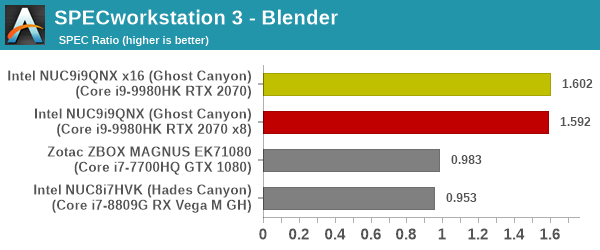
We find the Ghost Canyon NUC performing better than the reference configuration across all content creation workloads typically seen in the media and entertainment industry.
Product Development
The Product Development category comprises of eight distinct workloads:
- The Rodinia (CFD) workload benchmarks a computational fluid dynamics (CFD) algorithm.
- The WPCcfd workload benchmarks another CFD algorithm involving combustion and turbulence modeling.
- The CalculiX workload uses the Calculix finite-element analysis program to model a jet engine turbine's internal temperature.
- The Catia workload uses the catia-05 viewset from SPECviewperf 13 to replay traces generated by Dassault Systemes' CATIA V6 R2012 3D CAD application.
- The Creo workload uses the creo-02 viewset from SPECviewperf 13 to replay traces generated by PTC's Creo, a 3D CAD application.
- The NX workload uses the snx-03 viewset from SPECviewperf 13 to replay traces generated by the Siemens PLM NX 8.0 CAD/CAM/CAE application.
- The Solidworks workload uses the sw-04 viewset from SPECviewperf 13 to replay traces generated by Dassault Systemes' SolidWorks 2013 SP1 CAD/CAE application.
- The Showcase workload uses the showcase-02 viewset from SPECviewperf 13 to replay traces from Autodesk’s Showcase 2013 3D visualization and presentation application
| SPECworkstation 3.0.4 - Product Development Workloads | |||

Almost all workloads see the Ghost Canyon NUC performing significantly better than the reference configuration. The NX workload alone seems to suffer, likely on account of the trace requiring features supported in professional graphics cards.
Life Sciences
The Life Sciences category comprises of four distinct test sets:
- The LAMMPS set comprises of five tests simulating different molecular properties using the LAMMPS molecular dynamics simulator.
- The NAMD set comprises of three tests simulating different molecular interactions.
- The Rodinia (Life Sciences) set comprises of four tests - the Heartwall medical imaging algorithm, the Lavamd algorithm for calculation of particle potential and relocation in a 3D space due to mutual forces, the Hotspot algorithm to estimate processor temperature with thermal simulations, and the SRAD anisotropic diffusion algorithm for denoising.
- The Medical workload uses the medical-02 viewset from SPECviewperf 13 to determine system performance for the Tuvok rendering core in the ImageVis3D volume visualization program.
| SPECworkstation 3.0.4 - Life Sciences Workloads | |||
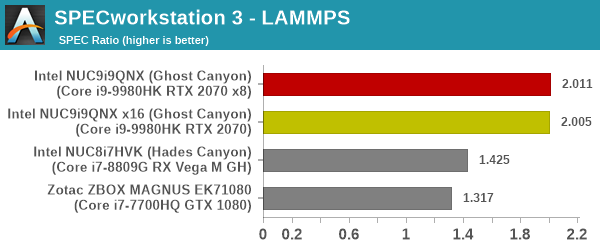
The trend repeats for all test sets in this category also, with the Ghost Canyon NUC acquitting itself in a creditable manner.
Financial Services
The Financial Services workload set benchmarks the system for three popular algorithms used in the financial services industry - the Monte Carlo probability simulation for risk assessment and forecast modeling, the Black-Scholes pricing model, and the Binomial Options pricing model.
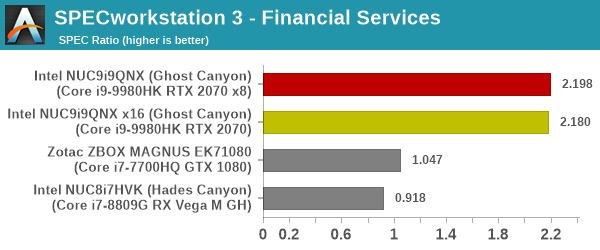
The large core count and ability to turbo to speeds of up to 5 GHz enable the NUC9i9QNX to process these algorithms in a fast manner.
Energy
The Energy category comprises of workloads simulating various algorithms used in the oil and gas industry:
- The FFTW workload computes discrete Fourier transforms of large matrices.
- The Convolution workload computes the convolution of a random 100x100 filter on a 400 megapixel image.
- The SRMP workload processes the Surface-Related Multiples Prediction algorithm used in seismic data processing.
- The Kirchhoff Migration workload processes an algorithm to calculate the back propogation of a seismic wavefield.
- The Poisson workload takes advantage of the OpenMP multi-processing framework to solve the Poisson's equation.
- The Energy workload uses the energy-02 viewset from SPECviewperf 13 to determine system performance for the open-source OPendTec seismic visualization application.
| SPECworkstation 3.0.4 - Energy Industry Workloads | |||
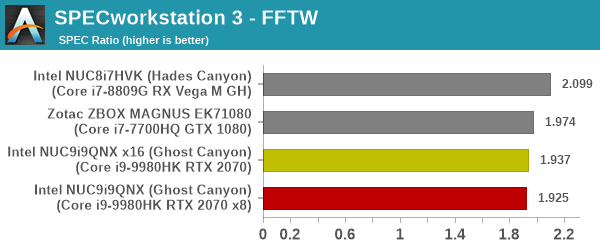
The NUCs seem to perform very poorly in the SRMP and Poisson workloads, but are otherwise quite good in the workloads in this category.
General Operations
In the General Options category, the focus is on workloads from widely used applications in the workstation market:
- The 7zip workload represents compression and decompression operations using the open-source 7zip file archiver program.
- The Python workload benchmarks math operations using the numpy and scipy libraries along with other Python features.
- The Octave workload performs math operations using the Octave programming language used in scientific computing.
- The Storage workload evaluates the performance of the underlying storage device using transaction traces from multiple workstation applications.
| SPECworkstation 3.0.4 - General Operations | |||
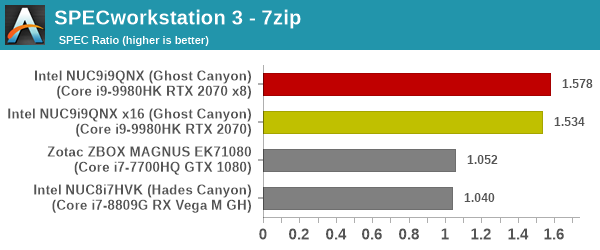
The Core i9-9980HK performs much better than the reference configuration as well as the older generation CPUs for the general operations. The storage results is again particularly interesting to analyze. Directly connecting the Optane SSD to the CPU's PCIe lanes results in a 40%+ performance improvement for the storage traces of professional applications.
GPU Compute
In the GPU Compute category, the focus is on workloads taking advantage of the GPU compute capabilities using either OpenCL or CUDA, as applicable:
- The LuxRender benchmark is the same as the one seen in the media and entertainment category.
- The Caffe benchmark measures the performance of the Caffe deep-learning framework.
- The Folding@Home benchmark measures the performance of the system for distributed computing workloads focused on tasks such as protein folding and drug design.
| SPECworkstation 3.0.4 - GPU Compute | |||
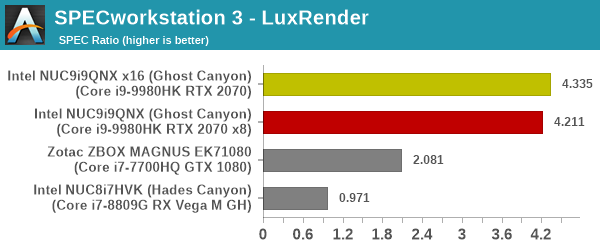










109 Comments
View All Comments
timecop1818 - Thursday, April 16, 2020 - link
Really bad selection of pictures. Did you not actually have a unit with you when reviewing? There's no external shots, there's no pics of the board/GPU connected together, there's no pics of rear backplane with ports/whatever, basically no useful info. I clicked through the gallery and I have no idea how big this thing is, or how the GPU fits into the picture, or anything else. Even "setup notes" page shows nothing useful.DanNeely - Thursday, April 16, 2020 - link
The chassis gallery on the 1st page shows the fully assembled system with the rear IO ports visible and gives a decent visual idea of how big the system is.timecop1818 - Thursday, April 16, 2020 - link
Oh hey, I see the stuff now. There's separate galleries throughout the article, for some reason I thought there was only one per page, and the 1st page only showed disassembled cpu module so I thought that was it. Thanks for pointing it out.FireSnake - Thursday, April 16, 2020 - link
Based on this:https://www.notebookcheck.net/AnandTech-editor-rep...
they are not getting any money from me!
For a loooong looong time (those includd too).
bug77 - Thursday, April 16, 2020 - link
It's a good thing you don't get hung up on details like proof and stuff. Guilty until proven innocent, eh? (And yes, I know history doesn't work in their favor.)DigitalFreak - Thursday, April 16, 2020 - link
Ian doesn't seem like the person to throw around baseless accusations.ganeshts - Thursday, April 16, 2020 - link
The tweet has been misinterpreted and now taken a completely unintended shape of its own. Ian plans to clarify the usage of the word 'incentive' in the context in an upcoming video / post.FWIW, if anyone believe AMD doesn't offer incentives to its partners (of a type similar to what Intel does, and what is completely legal), then the person has no idea of how the technology industry / silicon vendors operate.
If anyone thinks the reason for lack of high-performance AMD-based (read, Renoir) 'NUC's is Intel, then I have a bridge to sell. No one is preventing AMD from creating a reference design for a Renoir-based 4x4 board or innovate with Compute Element-like products. OEMs can take the plunge only if the silicon vendors offer them a proof of concept. If a Renoir NUC reference design exists, but OEMs still don't pick it up to offer them in the market, that would be worthy of deeper investigation (that could still throw up legitimate reasons).
Namisecond - Friday, April 17, 2020 - link
Even when reference designs exist, availability of parts can come into play, or even OEM disinterest.quadrivial - Friday, April 17, 2020 - link
AMD has reference designs and an entire set of embedded Zen 1 chips made explicitly for that purpose. Udoo Bolt was kickstarted by a fairly small company. If they could do it, why not bigger companies?arashi - Saturday, April 18, 2020 - link
You must understand that Intel PR and legal has been in touch.